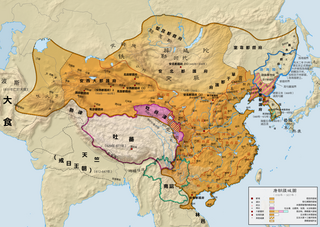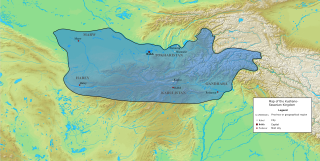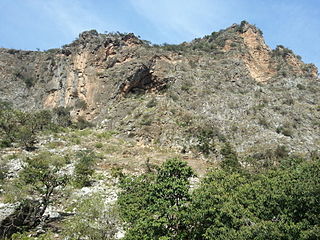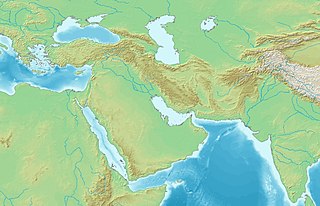
The Hephthalites, sometimes called the White Huns, were a people who lived in Central Asia during the 5th to 8th centuries CE. They formed an empire, the Imperial Hephthalites, and were militarily important from 450 CE, when they defeated the Kidarites, to 560 CE, when combined forces from the First Turkic Khaganate and the Sasanian Empire defeated them. After 560 CE, they established "principalities" in the area of Tokharistan, under the suzerainty of the Western Turks and of the Sasanian Empire, before the Tokhara Yabghus took over in 625.

Bactrian is an extinct Eastern Iranian language formerly spoken in the Central Asian region of Bactria and used as the official language of the Kushan, and the Hephthalite empires.

Xionites, Chionites, or Chionitae were a nomadic people in Transoxiana and Bactria.

The Kidarites, or Kidara Huns, were a dynasty that ruled Bactria and adjoining parts of Central Asia and South Asia in the 4th and 5th centuries. The Kidarites belonged to a complex of peoples known collectively in India as the Huna, and in Europe as the Chionites, and may even be considered as identical to the Chionites. The 5th century Byzantine historian Priscus called them Kidarite Huns, or "Huns who are Kidarites". The Huna/Xionite tribes are often linked, albeit controversially, to the Huns who invaded Eastern Europe during a similar period. They are entirely different from the Hephthalites, who replaced them about a century later.

Tokharistan is an ancient Early Middle Ages name given to the area which was known as Bactria in Ancient Greek sources.

Kushano-Sasanian Kingdom is a historiographic term used by modern scholars to refer to a branch of the Sasanian Persians who established their rule in Bactria during the 3rd and 4th centuries CE at the expense of the declining Kushans. They captured the provinces of Sogdiana, Bactria and Gandhara from the Kushans in 225 CE. The Sasanians established governors for the Sasanian Empire, who minted their own coinage and took the title of Kushanshas, i.e. "Kings of the Kushans". They are sometimes considered as forming a "sub-kingdom" inside the Sasanian Empire. This administration continued until 360-370 CE, when the Kushano-Sasanians lost much of its domains to the invading Kidarite Huns, whilst the rest was incorporated into the imperial Sasanian Empire. Later, the Kidarites were in turn displaced by the Hephthalites. The Sasanians were able to re-establish some authority after they destroyed the Hephthalites with the help of the Turks in 565, but their rule collapsed under Arab attacks in the mid 7th century.

The Kashmir Smast caves, also called Kashmir Smats, are a series of natural limestone caves, artificially expanded from the Kushan to the Shahi periods, situated in the Babuzai Sakrah mountains in the Katlang Valley Mardan in Northern Pakistan. According to recent scholarship based on a rare series of bronze coins and artifacts found in the region, the caves and their adjacent valley probably comprised a sovereign kingdom in Gandhara which maintained at least partial independence for almost 500 years, from c. 4th century AD to the 9th century AD. For most of its history, it was ruled by White Hun governors or princes.

Khingila I was the founding king of the Hunnic Alkhan dynasty. He was a contemporary of Khushnavaz.
Hunas or Huna was the name given by the ancient Indians to a group of Central Asian tribes who, via the Khyber Pass, entered the Indian subcontinent at the end of the 5th or early 6th century. The Huna Kingdom occupied areas as far south as Eran and Kausambi, greatly weakening the Gupta Empire. The Hunas were ultimately defeated by a coalition of Indian princes that included an Indian king Yasodharman and the Gupta emperor, Narasimhagupta. They defeated a Huna army and their ruler Mihirakula in 528 CE and drove them out of India. The Guptas are thought to have played only a minor role in this campaign.

Central Asian art is visual art created in Central Asia, in areas corresponding to modern Kyrgyzstan, Kazakhstan, Uzbekistan, Turkmenistan, Azerbaijan, Tajikistan, Afghanistan, Pakistan, and parts of modern Mongolia, China and Russia. The art of ancient and medieval Central Asia reflects the rich history of this vast area, home to a huge variety of peoples, religions and ways of life. The artistic remains of the region show a remarkable combinations of influences that exemplify the multicultural nature of Central Asian society. The Silk Road transmission of art, Scythian art, Greco-Buddhist art, Serindian art and more recently Persianate culture, are all part of this complicated history.

The Nezak Huns, also Nezak Shahs, were the last of the four Hunnic states in the area of the Hindu Kush, active from circa 484 to 665 CE. They ruled over Zabulistan and Kabulistan for about two centuries, spanning twelve generations. While their history remains obscured, the Nezaks left behind significant coinage—with a characteristic water-buffalo-head crown—documenting their polity's prosperity.

The Alchon Huns, also known as the Alchono, Alxon, Alkhon, Alkhan, Alakhana and Walxon, were a nomadic people who established states in Central Asia and South Asia during the 4th and 6th centuries CE. They were first mentioned as being located in Paropamisus, and later expanded south-east, into the Punjab and central India, as far as Eran and Kausambi. The Alchon invasion of the Indian subcontinent eradicated the Kidarite Huns who had preceded them by about a century, and contributed to the fall of the Gupta Empire, in a sense bringing an end to Classical India.

Kidara I fl. 350-390 CE) was the first major ruler of the Kidarite Kingdom, which replaced the Indo-Sasanians in northwestern India, in the areas of Kushanshahr, Gandhara, Kashmir and Punjab.

The term Iranian Huns is sometimes used for a group of different tribes that lived in Afghanistan and neighboring areas between the fourth and seventh centuries and expanded into northwest India. They are roughly equivalent to the Hunas. They also threatened the northeast borders of Sasanian Persia and forced the Shahs to lead many ill-documented campaigns against them.

Balalyk tepe, Uzbekistan, is a Central Asian archaeological site with many mural paintings. It was the site of a small fortified manor belonging to a princely Hephthalite clan. It is generally dated a bit later than the painting at Dilberjin, from the late 5th century to the early 7th century CE, or from the end of the 6th century to the early 7th century CE. The paintings of Balalyk Tepe are part of a "Tokharistan school", which also includes Adzhina-tepe and Kafyr-kala. They are succeeded chronologically by the Sogdian art of Penjikent.

The Hephthalite silver bowl is a bowl discovered in the Swat region of Gandhara, Pakistan, and now in the British Museum. It dates from 460-479 CE, and the images represent two different Huna tribes, suggesting a period of peaceful coexistence between the Kidarites and the Alchons.

The murals of Penjikent are among the most famous murals of the pre-Islamic period in Panjakent, ancient Sogdiana, in Tajikistan. Numerous murals were recovered from the site, and many of them are now on display in the Hermitage Museum in Saint Petersburg, and in the National Museum of Antiquities of Tajikistan in Dushanbe. The murals reveal the cosmopolitan nature of the Penjikent society that was mainly composed of Sogdian and Turkic elites and likely other foreign merchant groups of heterogeneous origin. Significant similarities with Old Turkic clothing, weapon items, hairstyles and ritual cups are noted by comparative research.

Stamp seal , is a historical stamp seal from the British Museum, with reference number BM 119999, located in Room 52 of the museum. The stamp seal was procured by Sir Alexander Cunningham, who sold it to the British Museum in 1870. Another, nearly identical, seal, is located in the Calcutta Museum.

Pei Ziye was a Chinese historian of the southern Liang dynasty. He was the son of another historian, Pei Yin (裴駰), a grandson of the famous historian Pei Songzhi. Pei Ziyi is, among other things, known for making a mistaken conjecture about the origin of the Hephthalites, who just sent an embassy at the Chinese court of the Liang dynasty in 516 CE, saying that they may be descendants of the Jushi based on a false etymology. This account appears in the Liangshu :
是時西北徼外有白題及滑國,遣使由岷山道入貢。此二國歷代弗賓,莫知所出。子野曰:「漢潁陰侯斬胡白題將一人。服虔《注》云:『白題,胡名也。』又漢定遠侯擊虜,八滑從之,此其後乎。」時人服其博識。
During this period, there were beyond the Northwestern frontier, the states of Boti and Hua, who sent envoys through the mountain road of the Min to offer tribute. These two states had not been guests of the successive dynasties, their origin was unknown. Ziye said: "There was Baiti, a hu general who was killed by Marquis Yingyin of Han. Fu Qian's commentary to the Hanshu says: 'Baiti is a hu name'. Moreover, it is known that the Marquis Dingyuan was accompanied by Bahua when attacking the Barbarians, so perhaps these two states are their descendants." His contemporaries admired his wide knowledge.

Tobazini, Gobazini or Goboziko was a ruler of southern Central Asia. He is only known from his coinage, found in Bactria and Northern Afghanistan. The legends on his coins are in Bactrian, but they are often difficult to read: a typical legend reads t/gobazini/o šauo "King Tobazini". Tobazini is often considered one of the last rulers of the Kidarites, circa 450 CE.

![]() , εϸκιγγιλο, Eškiŋil) may be a title consisting in the Turkic prefix Eš- meaning “comrade, companion of” and "-kenglu", the sacred sword and god ("Kenglu-shen") worshipped by the Xiongnu, so that "Eškiŋgil" could be a Hunnic name or title meaning “Companion of the Sword”, or even "Companion of the God of War". [8] [1]
, εϸκιγγιλο, Eškiŋil) may be a title consisting in the Turkic prefix Eš- meaning “comrade, companion of” and "-kenglu", the sacred sword and god ("Kenglu-shen") worshipped by the Xiongnu, so that "Eškiŋgil" could be a Hunnic name or title meaning “Companion of the Sword”, or even "Companion of the God of War". [8] [1] ![]() (χιγγιλο αλχοννο "Khiggilo Alchono"), or another ruler of the same name. [4] A Turk Shahi ruler of Kabul is also known in Arab sources as Khinkhil or Khinjil, who, according to Al-Yakubhi, gave his submission to Al-Mahdi in 775–785. [9] A ruler Khingila is also mentioned in the dedication of the Gardez Ganesha. The identity of this Khingala is uncertain. [10]
(χιγγιλο αλχοννο "Khiggilo Alchono"), or another ruler of the same name. [4] A Turk Shahi ruler of Kabul is also known in Arab sources as Khinkhil or Khinjil, who, according to Al-Yakubhi, gave his submission to Al-Mahdi in 775–785. [9] A ruler Khingila is also mentioned in the dedication of the Gardez Ganesha. The identity of this Khingala is uncertain. [10] 


















